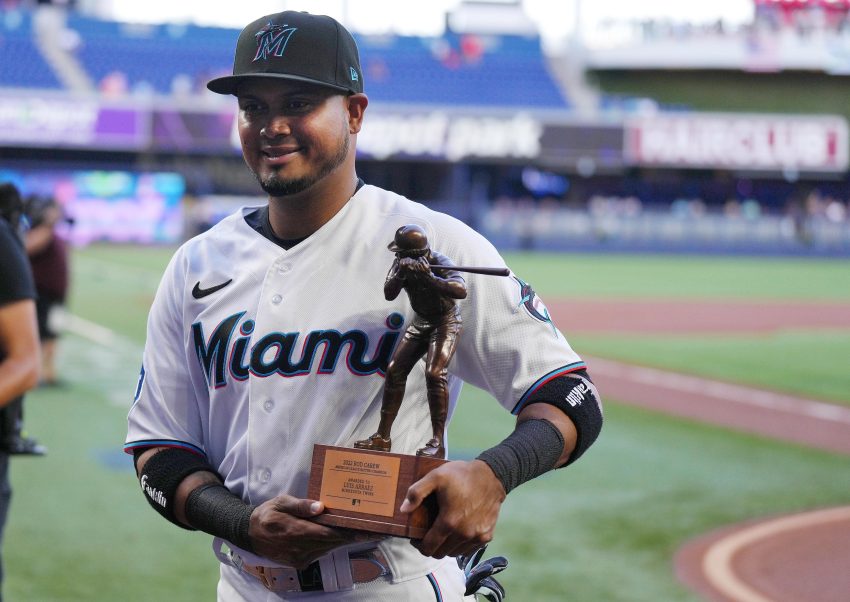
Twins fans fell in love with Luis Arráez from the moment he stepped on the field. His offensive approach was reminiscent of Twins Hall of Famer Rod Carew, and his on-field energy was infectious. After all, how many players can boast three consecutive batting titles by age 27? Yet, as Arráez prepares for what might be his fourth uniform in as many seasons, his story is one of a changing baseball landscape and shifting organizational priorities.
Arráez’s baseball journey has taken him from being a fan favorite in Minnesota to the Miami Marlins to his current stint with the San Diego Padres. It also reveals why his skill set, while impressive, is not enough to make teams commit long-term.
The Twins: Pitching Over Contact
Arráez became a fan favorite in Minnesota thanks to his exceptional bat-to-ball skills, winning his first batting title in 2022. In 144 games, he hit .316/.375/.420, with a 128 OPS+ and 4.2 rWAR. Yet, that same offseason, the Twins made the decision to trade him to the Miami Marlins for Pablo López.
For Minnesota, the origin of the trade was simple: they needed starting pitching, and López fit the bill. While Arráez provided elite contact hitting, his lack of power, speed, and defensive versatility limited his overall impact. He had moved down the defensive spectrum to the point where the Twins viewed him as a first baseman or designated hitter. The Twins’ front office recognized that the value of a high-average singles hitter was declining in an era driven by slugging percentages and defensive flexibility. In hindsight, the Twins’ move might have been ahead of its time.
The Marlins: A Front-Office Rebuild
Arráez’s lone full season in Miami was nothing short of spectacular. He captured his second batting title, becoming the first Marlin to achieve the feat. In 147 games, he posted a career-high 4.9 WAR while hitting .354/.393/.469 with a 128 OPS+ identical to the one he posted for the Twins the prior season. He finished eighth in the NL MVP voting, was an All-Star, and won a Silver Slugger Award. However, Miami’s front office underwent significant changes last offseason, with general manager Kim Ng departing and the team pivoting toward a rebuild.
In this new direction, Arráez became a luxury rather than a necessity. His arbitration-fixed salary of over $10 million was steep for a team looking to shed payroll and accumulate younger, controllable assets. Miami decided to move on, flipping Arráez to the San Diego Padres last season as part of a cost-cutting effort. Miami acquired four prospects for Arráez: Dillon Head, Woo-Suk Go, Jakob Marsee, and Nathan Martorella. It showed how much his value had dropped in one season.
The Padres: Cost-Cutting Constraints
San Diego’s acquisition of Arráez initially seemed like a natural fit. His contact-oriented approach complemented a star-studded but strikeout-prone lineup. In 150 games, he hit .314/.346/.392 while leading the NL with 200 hits. That bakes in a tough start with Miami, too; he was better after being dealt in early May. However, his overall value dropped significantly, with a 106 OPS+ and a 1.1 WAR. Arráez won his third consecutive batting title, but his value has come into question as the Padres face mounting financial pressures.
For the second straight offseason, San Diego is facing a payroll crunch, and Arráez’s escalating arbitration figure (over $14 million) makes him a prime trade candidate. According to FanGraphs, his on-field 2024 production value ($8.8 million) is significantly lower than his salary, particularly after thumb surgery this October introduced uncertainty about his future production.
The Decline of the Singles Hitter
Arráez’s situation highlights a broader trend in baseball, with the devaluation of singles hitters. The modern game prizes power, speed, and defensive versatility, and players like Arráez who excel in one narrow facet of the game are becoming harder to build around.
Arráez’s elite contact skills have undeniable value, but don’t outweigh his defensive limitations or lack of power. His Hard Hit%, Barrel%, and BB% rank in the third percentile or lower among MLB hitters. Also, advanced metrics like Wins Above Replacement (WAR) reflect how his bat alone can’t carry his profile, especially with his defensive limitations (-13 OAA in 2024).
Did the Twins See the Future?
In retrospect, the Twins may have been proactive in trading Arráez when they did. While López blossomed into an ace, Arráez’s limitations are becoming more apparent. He was an MVP candidate during his peak, but the gap between his arbitration cost and actual on-field value is widening, in the wrong direction.
Arráez remains a unique talent in today’s game, and fans love his ability to do what few others can—hit for average at an elite level. But his career path underscores how baseball has evolved, and how even batting champions must adjust to the sport’s shifting priorities. For teams like the Padres, Marlins, and Twins, the question remains: Is Arráez worth the price? So far, the answer seems to be no.
